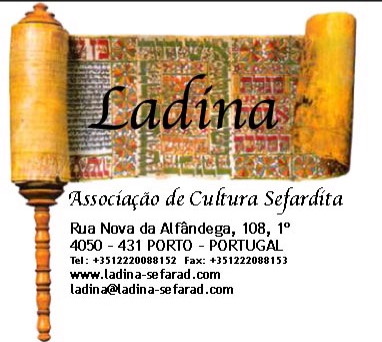LISBON 1506, THE MASSACRE OF THE JEWS, book review
 The author Susana Bastos Mateus with Yaacov Gladstone at the Alberto Benveniste Centre for Sephardic Studies at the New University of Lisbon.
The author Susana Bastos Mateus with Yaacov Gladstone at the Alberto Benveniste Centre for Sephardic Studies at the New University of Lisbon. Authors Susana Bastos Mateus and Paulo Mendes Pinto
Authors Susana Bastos Mateus and Paulo Mendes Pinto
at recent book launch in Lisbon
BOOK REVIEW
Lisboa 1506, O Massacre Dos Judeus
Lisbon, 1506, The Massacre of the Jews
Susana Bastos Mateus, Paulo Mendes Pinto, 2007, Alêtheia Editores, Lisboa.
By mlopesazevedo
(www.friendsofmarranos.blogspot.com)
This is the first non-fiction book in Portuguese, about the massacre in Lisbon of 4,000 Marranos*, Jews who were forcibly baptized in Portugal in 1497. During three days at Pessach (Passover), in April 1506 (Nisan, 28,29,30, 5266), an unruly mob, incited by fanatical Dominican monks killed between 1,000 and 4,000 innocent men, women, and children.
Apart from reference in Alexandre Herculano's classic, History of the Origin and Establishment of the Inquisition in Portugal in the mid 19th century, there has been virtually nothing written by modern Portuguese authors on the subject. The massacre was described in one of the earliest books written in Portuguese, Samuel Usque’s Consolação às Tribulações de Israel, Ferrara, 1553,
Among these were two Dominican friars, who went through the city of Lisbon with crucifixes on their shoulders, inciting the people and calling for all to join them to avenge the death of their god…they attacked the weak and defenceless group of ill-baptized New Christians with spears and unsheathed swords. They killed four thousand of them…
(English translation of Martin A. Cohen, Consolation for the Tribulations of Israel, The Jewish Publication Society of America, Philadelphia, 1977, p. 205)
The co-authors of this small but well organized book, instructors at the Alberto Beneviste Centre for Sephardic Studies at the New University of Lisbon, refer not only to Usque and other contemporary accounts but also review modern articles and reviews such as Yosef Hayim Yerushalmi’s, Le Massacre de Lisbonne en 1506 et l’image du roi dans le Shebet yehudah, Sefardica, Paris, Chandeigne, 1998.
The book starts with a much needed succinct overall history of Iberian Jews, including their mass migration to Portugal in the 14th and 15th century, especially after the Edict of Expulsion of 1492 by the Catholic Monarchs which resulted in over 100,000 Jews entering Portugal, then with a population of about one million. Although in December 1496, King Manuel, under pressure from his Spanish in-laws, ordered Jews to leave by October 1497, he changed his mind, prohibited their departure and forcibly baptized them in 1497.
The massacre occurred at the height of the plague when over 100 people were dying each day in Lisbon. The Jews were of course blamed for the plague and the prolonged drought. The King had fled Lisbon. During a service on Sunday afternoon at St. Dominic’s church (still standing in Lisbon, next to the Rossio), a New Christian questioned a claim of a supposed miracle involving the crucifix, perhaps pointing out that a piece of wood was incapable of a miracle (the contemporary narrations differ). He was dragged out to the square in front of the church, beaten and quartered before being burned. His brother met the same fate. For three days the rioting and looting continued. The elderly and the young were not spared. At one point there was a mound of over 400 dead bodies in the Rossio (the main square of downtown Lisbon). At one point, German merchants paid for wood for the pyre, which had run out.
Soon after the massacre the King ordered the public execution of the two Dominican monks and about 60 ringleaders. He withdrew certain privileges and imposed sanctions on the city of Lisbon. He renewed for another 20 years, the period in which the former Jews would not be subjected to inquiries about their private religious practices (hence the formation of a unique Marrano culture in Portugal). He also permitted the New Christians to leave the realm and sell their possessions.
The authors offer a historical and political analysis of the consequences of the massacre as well as generous historical explanatory notes throughout the text, making this a useful text to
ordinary readers. A review of Jewish and non-Jewish literature, as well as an extensive bibliography should also appeal to scholars.
The occasional black and white image, mostly of Inquisitorial scenes (there is only one known contemporary image of the massacre itself) lends the work an aura of authenticity and sombreness.
This book a welcome addition to a growing body of recent books on Portuguese Jewish history which are slowly uncovering the constructed memory loss which has concealed the true history of Portugal for far too long. For a fictional account of the Lisbon massacre, see Richard Zimler's 1998 novel, The Last Kabbalist of Lisbon, available in several languages. The Friends of Marranos (friendsofmarranos.blogspot.com) are accepting donations for the translation and publishing of this book into English.
*Marranos, at one time a pejorative term applied to Jews who were forcibly baptized in Spain in 1391 and in Portugal in 1497, is in common usage by some academics in Portugal who attribute its origin to the Aramaic-Hebrew Mar Anus, forced one, like the widely used Hebrew term today, Anousim. Christianity adopted the nomeclature of Converso or New Christian, who were not necessarily Marrano. The term Marrano is used here because of its association with the forced baptism of 1497 and the Inquisition, its acceptance in Portugal, and its growing meaning as a badge of identity and resistance to the demonic unHoly Office of the Inquisition (which still exists!).




